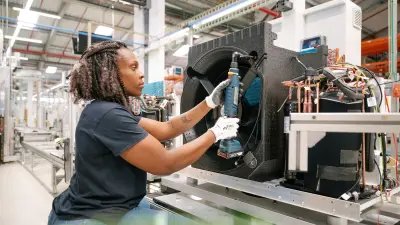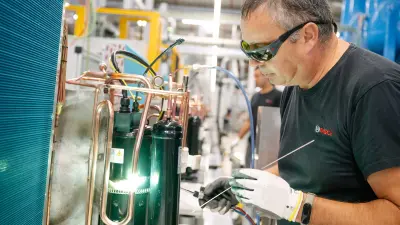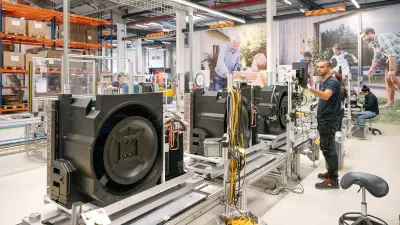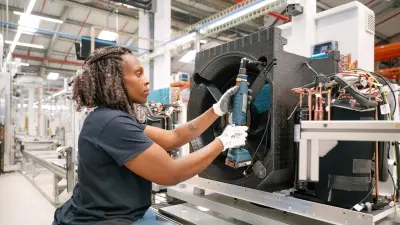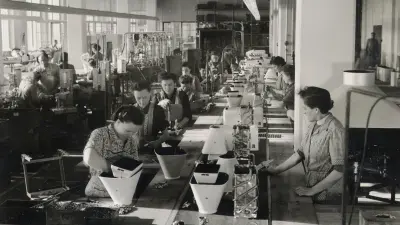Heat pumps for energy-efficient heating
How the move to alternative heating can succeed in Europe
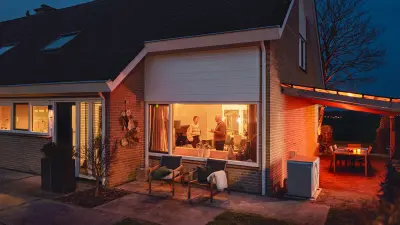
Why is the heat pump an important building block in the move to alternative heating in Europe? It’s quite simple: using electricity, it can generate heat for heating and hot water very efficiently. Running a heat pump on electricity from renewable energy sources also makes it eco-friendly. This is why Bosch is investing in the development and manufacturing of heat pumps as well as in the training of heating engineers. In Germany alone, the company trained over 20,000 installers on the subject of the electrification of heating technology in 2023. Bosch’s research and development aims to optimize the efficient use of heat pumps in new buildings. For existing buildings, of which there are 200 million across Europe, the company is promoting both stand-alone and hybrid heat-pump solutions.
Use in the Netherlands
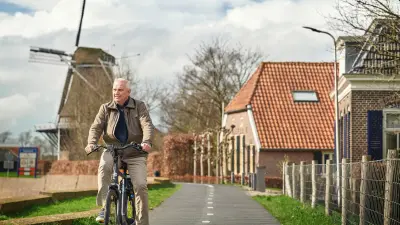
Gert Brommer from Hasselt in the Netherlands knows a thing or two about this kind of hybrid solution. As he drives home from work in the evening, he gazes out across a typically Dutch small-town scene. It’s springtime: the wind is driving rain clouds in from the coast and over the land, Hasselt’s historic windmill can be seen nearby, and the first flowers are coming into bloom in the meadow behind the house. In front of the house, there stands a Bosch heat pump. What is unusual about this model is that it isn’t yet available on the market in the Netherlands. It’s a highly integrated hybrid heat pump that is combined with a gas-fired heater and saves space by doing without an additional indoor unit.
Gathering experience to find the solution
Brommer is taking part in a field test. Before launching the hybrid system on the market in the near future, Bosch wants to put the system through its paces with a view to further improving it and ensuring it is suitable for everyday use and easy to install. Brommer is the perfect man for the job — as a trainer at Bosch Home Comfort, he teaches installers how to set up heating systems. He’s familiar with the technology, and he knows what customers and installers expect from Bosch. Quite apart from that, he bought his house on the outskirts of Hasselt a few years ago and is renovating it bit by bit. “I had to ask myself, ‘What heating system would work well for a house that was built in 1979?’” For a purely electric heat pump to make sense, the house would have had to be thoroughly insulated and renovated. And as in most detached houses in the Netherlands, there is very little space for additional building-services technology.

Heat-pump hybrid as a solution
The new, highly integrated heat-pump hybrid has been developed precisely with this in mind. Unlike other systems, it doesn’t require an additional indoor unit. In normal operation, the heat pump takes care of heating the house. The gas-fired heater is only ever used for hot water or when demand for heat is high, for example on cold winter days. That way, the house is kept warm at all times and the family always has enough hot water for showers. Brommer has managed to slash his gas consumption without resorting to a costly full remodel. He’s certain of one thing: “The new heat-pump hybrid is the perfect solution for me. I save on power and gas, and it heats my house in a more climate-friendly way.”
Brommer connected the Bosch Compress Hybrid 5800i heat pump to his existing heating system, which was equipped with a gas-fired boiler supplied by Bosch’s Dutch subsidiary Nefit. The heat pump is not only particularly compact but also very quiet, and uses the eco-friendly refrigerant propane. But how do the two systems manage to work together so perfectly?
Testing for the perfect settings
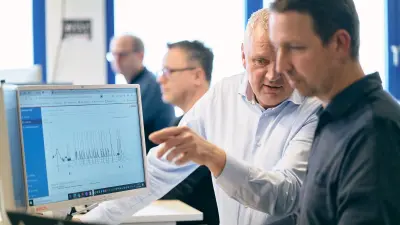
The findings from this field test are incorporated directly into further development work at Home Comfort in Deventer, the division’s location in the Netherlands. Here, only about an hour away from Brommer’s home, he and his colleagues are constantly evaluating the data from the system. “We can see right away how the system reacts to, say, a change in the weather, and whether we can optimize the settings any further,” he says.
In addition to optimizing the devices themselves, another crucial step in ensuring that the market launch in spring 2024 goes smoothly is to provide installers with comprehensive training in good time. This is something Brommer knows only too well from his work. It’s his job to train installers on how the devices work and how to put the systems into operation better and faster. In view of rising construction costs and a shortage of skilled workers, any time saving and quality gain that construction sites can achieve is valuable. This is why Bosch offers a comprehensive training program for service engineers.
From Essen to Mülheim: installing heat-pump technology professionally
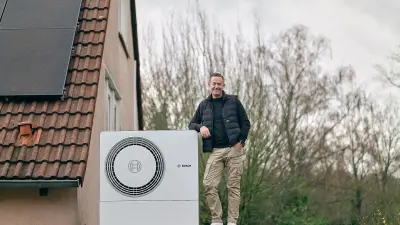
One of the specialists to have been trained in this way is the master heating engineer Andreas Hanf from Essen, Germany. Last year alone, he and his team installed some 100 heat pumps in the west of the country. But even though they already possess a wealth of experience with this technology, Hanf opted for a training program at Bosch that would qualify him as a heat-pump specialist.
“I think it’s good that a manufacturing company is offering these training courses. When we trained to become heating engineers, the focus was on conventional gas- and oil-fired heating systems. In view of demand and the shortage of skilled workers, these training courses are very important. Being well trained not only improves the quality of our work, but it also makes us around 20 percent faster.”
On today’s agenda: heat pump for a single-family home
HaWe GmbH is a heating and air conditioning company and a long-standing Bosch partner for heating technology. Its premises are located in the middle of a busy industrial park in Essen, in the Ruhr area. A truck drives up. Today, it delivers a Bosch Compress 6800i AW heat pump. The day is just dawning, and gray clouds are shrouding everything in a gloomy light.
The installation of a heat pump is in today’s schedule. As soon as it’s unloaded from the delivery truck, several people help lift it into a company van. Hanf and his team get ready to transport the heat pump to its destination, where he’ll again need many hands to install it on a customized chassis.

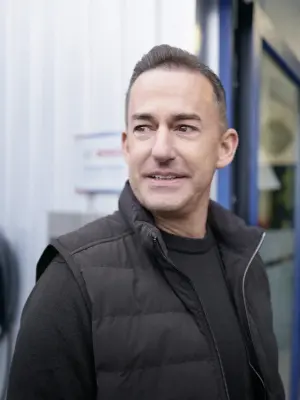
In view of demand and the shortage of skilled workers, these training courses are very important. Being well trained not only improves the quality of our work, but it also makes us around 20 percent faster.
Energy neutrality as a goal, quiet and compact
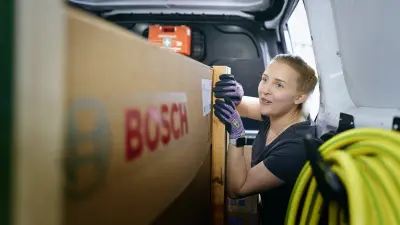
The house belongs to Hanf and his wife Lena Maria Welter, who manages the books and all commercial affairs at HaWe. Welter and Hanf want to make their house as energy neutral as possible. The heat pump will run on electricity generated by the photovoltaic system on the roof of the house.
Loading the heat pump into the company van isn’t child’s play: even without refrigerant, the Compress 6800i weighs a good 140 kilograms. “But it’s much more compact in size than previous generations, and much easier to transport,” Hanf says.
At 25.8 decibels, measured from a distance of three meters, these pumps produce a negligible amount of noise. Plus, Bosch’s new models use the natural refrigerant R290 (propane), which has a low global warming potential value. That means they pay off for customers not only economically but also ecologically.
Through a post-fossil landscape to climate-friendly use
The journey to the destination leads out of Essen in the direction of Mülheim an der Ruhr, around 20 kilometers west of the company headquarters in Essen. Just a few decades ago, this region was still a center of coal mining. Heat-pump technology is an important building block in the move away from fossil fuels.
“Ideally, ambient energy is used to generate three-quarters or more of the heat, and the amount of electricity the heat pump consumes is only one-quarter of its total output,” Hanf says, provided the house is well insulated and a low flow temperature is selected. “If the electricity consumed comes from renewable sources, as in our case, then the heat-pump technology is particularly climate friendly,” he adds.
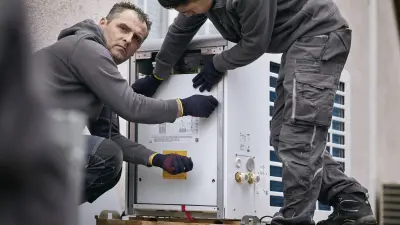
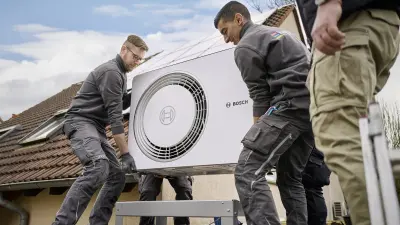
Installing the heat pump is only the first step. Next, it has to be connected to the electricity supply and to the house’s heating circuit. And then the pump needs to be programmed to provide heating and hot water for the bathroom and kitchen as required, whatever the weather.
“As of the day after tomorrow,” Hanf says happily, “the system will be up and running!” And then, like a good omen, the sun breaks through the clouds for the first time on this spring day.
The example of Aveiro: heat pumps “made in Europe”
Bosch is systematically driving electrification forward as it helps decarbonize the more than 200 million buildings in Europe. To meet the demand for heat pumps — including those that will go into volume production following field tests such as Brommer’s as well as those that are supplied to heating engineers like Hanf — Bosch will have invested over 1 billion euros in its European heat-pump development and manufacturing network by the end of the decade.
Among the beneficiaries are the company’s German locations and a new plant in Poland. In addition, some 100 million euros will go into expanding the site in Aveiro, Portugal, by 2026. Here, the company plans to build new laboratories, new production buildings, and additional heat-pump production lines. As plant manager Jónio Reis sees it, this was a logical decision. With many years of experience in manufacturing and developing heat pumps, the site is competitive. “Aveiro plays a crucial role in enabling Bosch to respond quickly to growing demand in Europe.”
Key technology for a carbon-neutral building stock
For Bosch, one thing is certain: as Europe works to achieve its climate targets, heat pumps are an important building block and the key technology. The only way to make Europe’s building stock carbon neutral is with heat pumps and heat-pump hybrids. That is why Bosch is making systematic investments to ensure that sustainable heating becomes established and that customers opt for heat-pump technology that combines ecology and economy — whether in the Netherlands, Germany, or Portugal.

